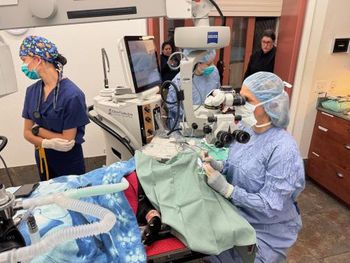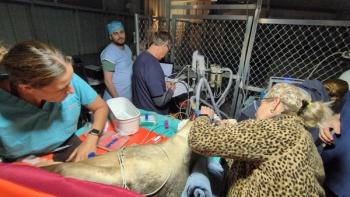
The dos and don'ts of treating ocular disease in cats (Proceedings)
Apocrine sweat gland tumors in the glands of moll. Single or multiple, dark color, benign, resemble human apocrine hidrocystomas.
Topics
• Eyelid Agenesis, Apocrine Gland Hidrocystoma, Feline Herpes Virus, Corneal Sequestrum. Eosinophilic Keratitis, Acute Bullous Keratopathy, Diffuse Iris Melanoma, Persistent Pupillary Membranes, Cataracts/Lens Luxation, Hypertensive Retinopathy
Eyelid agenesis
• The congenital absence of a portion of an eyelid
• Associated with excessive evaporation and inadequate dispersion of tear film, trichiasis, secondary keratoconjunctivitis, pain, corneal Ulceration
• Treatment: Variety of blepharoplastic procedures, choice depends on size and position of defect, cryotherapy for trichiasis
Apocrine gland hidrocystomas
• Common in Persians/himalayan
• Apocrine sweat gland tumors in the glands of moll. Single or multiple, dark color, benign, resemble human apocrine hidrocystomas
• Unknown cause: Two theories: Lesion is a proliferative adenomatous tumor, lesion is a retention cyst
• Treatment of Hidrocystomas: "Observation without treatment" aka benign neglect, drainage and surgical excision (generally recur 6-12 months ), debridement and topical 20% trichloroacetic acid (no recurrence at 12 months)
Feline herpes virus: it's herpes until proven otherwise
• Alphaherpesvirus. High seroprevalence (90%), Transmission: Direct contact, Aerosolization
• Infects epithelial cells lining the respiratory tract, conjunctiva and corneal epithelium. Replicating virus results in cytolysis, inflammatory mediated cell damage
• Occurs 4-6 days post-exposure
• Establishes latency in trigeminal ganglia (80% of cases)
• 45% spontaneously reactivate
• Primary Infection: Maternal antibody wanes at 8-12 weeks, generally self-limiting (10-20d)
• **Conjunctivitis, Hyperemia, Blepharospasm, Chemosis, Ocular discharge- serous to purulent, Ulceration,
• Fibrinous/cellular exudate
Feline herpesvirus-1: sequellae
• Dendritic Corneal ulceration, Ophthalmia neonatorum, Symblepharon, usually occur during severe primary infection, stromal keratitis, eosinophilic keratitis, anterior uveitis, corneal sequestra, KCS, NLD stricture
Feline herpesvirus-1: diagnosis
• PCR: Not clinically useful because of high prevalence in feline population
• Virus Isolation in cell culture: Insensitive for chronic infections
• Fluorescent Antibody (lacks sensitivity)
• Cytology: Primary infection - Intranuclear inclusion bodies may be seen
• Antibody detection (serology) : Not useful in vaccinated cats
• Cause, coinciding, coincidence
Feline herpesvirus-1: treatment
• Control 2° bacterial infections: Tetracycline to treat Chlamydia and Mycoplasma
• Antiviral therapies. Topical (Idoxuridine, Cidofovir, Trifluridine). Systemic (Famciclovir, L-Lysine 500mg BID, Interferon). Decrease stress
Chlamydophila felis
• Transmission: Airborne, direct, fomite
• Incubation = 3-5 days
• Shed ~60 days
• Clinical signs: Young cat (under 1 yr), Unilateral progresses to bilateral in 7 days, CHEMOSIS, hyperemia, serous discharge, blepharospasm. Generally resolve by ~110 days post-infection
• Diagnosis: Cytology (Intracytoplasmic reticulate bodies (days 3-14)). PCR, Serology (>32), ELISA, IFA (conj scraping), Cell culture.
• Prevention: Vaccination- MLV and killed
• Treatment: Tetracyclines (Doxycycline, Clavamox). Topical terramycin or erythromycin
Mycoplasma spp (m. Felis, m. Gatae)
• Questionable clinical significance. Isolated from clinically normal cats (>80%). Variable conjunctivitis in experimentally infected kittens. Unable to produce clinical disease in experimentally infected adult cats
• Diagnosis: Culture, Cytology (Epithelial cytoplasmic basophilic inclusions), PCR (M. felis) - High sensitivity/specificity
Corneal sequestrum: corneal necrosis
• Unique to cats. Persian, Burmese, Himalayan at high risk
• Cause: Chronic irritation/ulceration, most commonly feline herpes virus and in brachycephalic breeds
• Signs: black plaque, blepharospasm, epiphora, vascularization, Ulceration
• Do not debride, Do not perform a keratotomy
• Treament: Medical Management (Warn the owner there is always a risk of eye perforation with medical management). Topical Anti-viral, Topical Antibiotic, Thick lubrication artificial tear (Genteal gel, I-drop Vet, Tears Renewed).
• Surgical Therapy (best): Superficial Keratectomy
Eosinophilic keratitis: think "white plaques"
• Proliferative, white to pink, edematous, irregular, vascularized ingrowth. Originates at the nasal or temporal limbus, adjacent conjunctiva is involved
• Diagnosis : Cytology: Eosinophils and neutrophils predominant, Mast cells occasionally present
• Treatment: Topical corticosteroids, Topical cyclosporine/tacrolimus
Mycobacterial keratitis
• Aerobic, non motile, acid fast bacteria
• Diagnosis: cytology
• Chronic in nature requiring long term therapy
• Fluoroquinolones treatment of choice - moxifloxacin
• Lamellar or penetrating keratoplasty may be required
Acute bullous keratopathy
• Formation of vesicles in the epithelium and stroma of an edematous cornea:
• Diagnosis: Clinical exam findings
• Treatment: *Hyperosmotic sodium chloride ointment (5%), *Topical antibiotics if ulcerated, *Third eyelid flap, Complete 360 degree conjunctival graft, Thermokeratoplasty
Diffuse iris melanoma
• Usually slowly progressive (months to years)
• Arise from pigmented anterior iris surface
• Secondary effects: Glaucoma, may affect pupil shape and mobility, uveitis
• Metastasis: 1 report of 63% metastasis rate, Liver, Spleen, & Kidneys > Lung, drainage angle & scleral venous plexus involvement increase risk of metastasis. 1 to several years after enucleation. Many cats, even with metastasis, live many years with few ill effects
• Treatments: Early — Laser cytophotocoagulation/ablation, Enucleation/Evisceration, Adjunctive therapies: Xenogenic DNA Melanoma Vaccine ????
• When to consider enuclation: Noticeable thickening of iris stroma with dyscoria or pupil mobility, involvement of ciliary body, extension into sclera, secondary glaucoma, intractable uveitis
Persistent pupillary membranes: embryonic remnants fetal blood vessels
• Location: Iris to Iris, Iris to cornea (Cornea opacities), Iris to lens (Cataracts)
• Difference from synechia because arise from iris collarette not pupillary margin
Cataracts/lens luxation
• It happens in cats
• Primary and inherited cataracts are rare and usually congenital
• Secondary: Traumatic, *Anterior uveitis, Glaucoma, Lens luxation (secondary to chronic uveitis and glaucoma)
• Treatment: Cats do very well with phacoemulsification surgery. Lensectomy for lens luxation (less glaucoma seen compared to canines)
Hypertensive retinopathy
• Acutely blind cat (happens in dogs too!)
• Can see the retina billowing towards you without a lens
• Work up: Blood pressure, Chemistry panel and CBC
• Treatment: Anti-hypertensive oral medications, Pred Acetate topically TID
Newsletter
From exam room tips to practice management insights, get trusted veterinary news delivered straight to your inbox—subscribe to dvm360.




